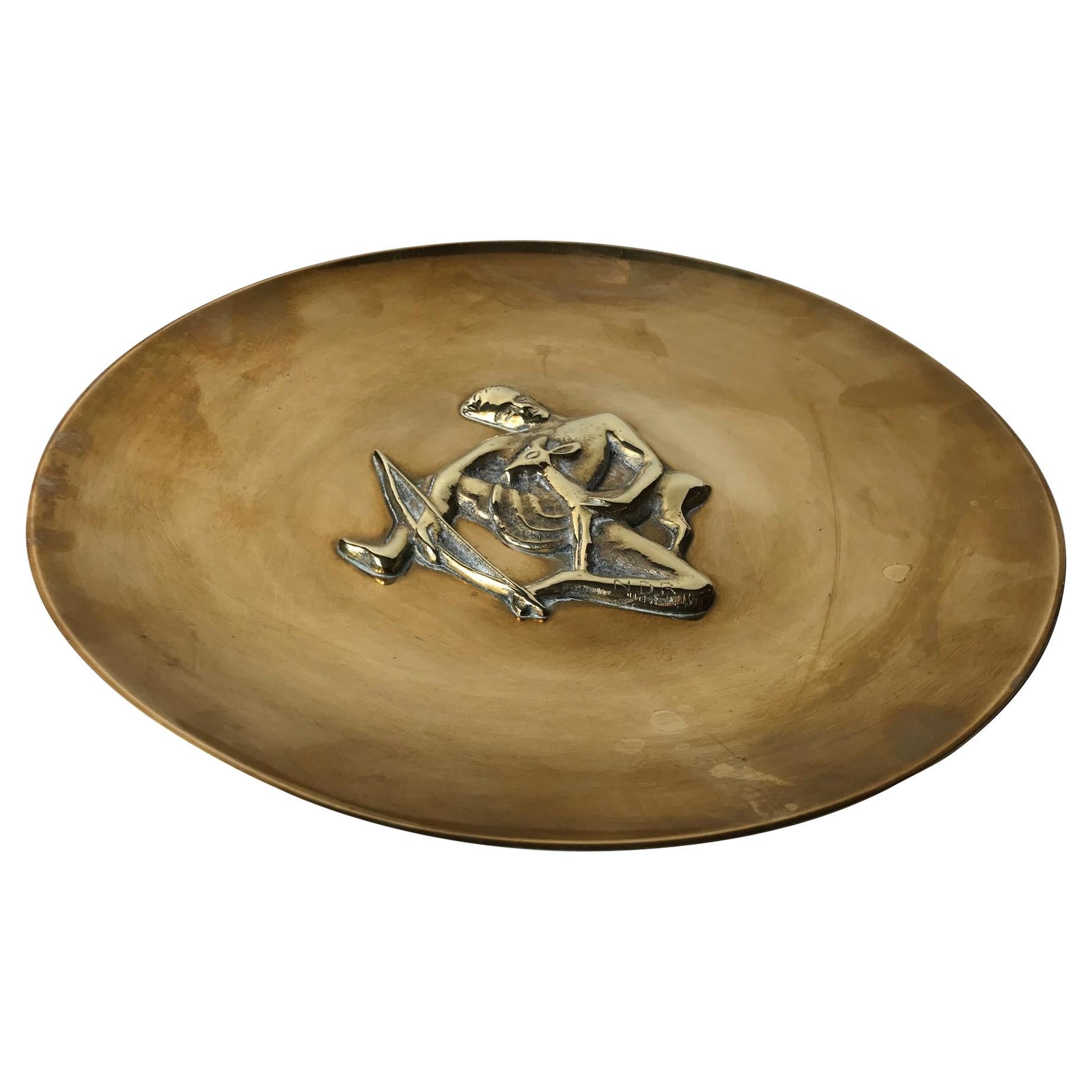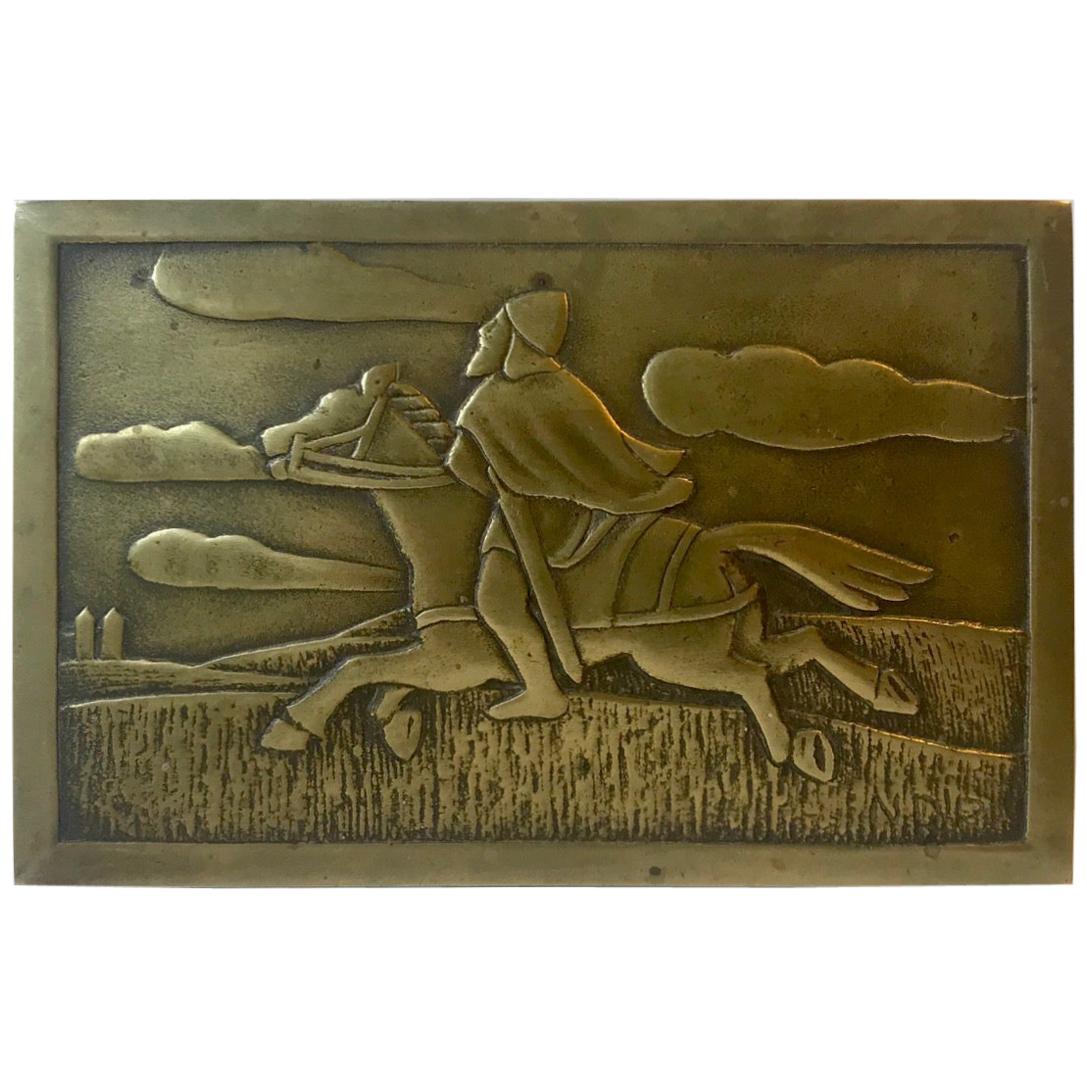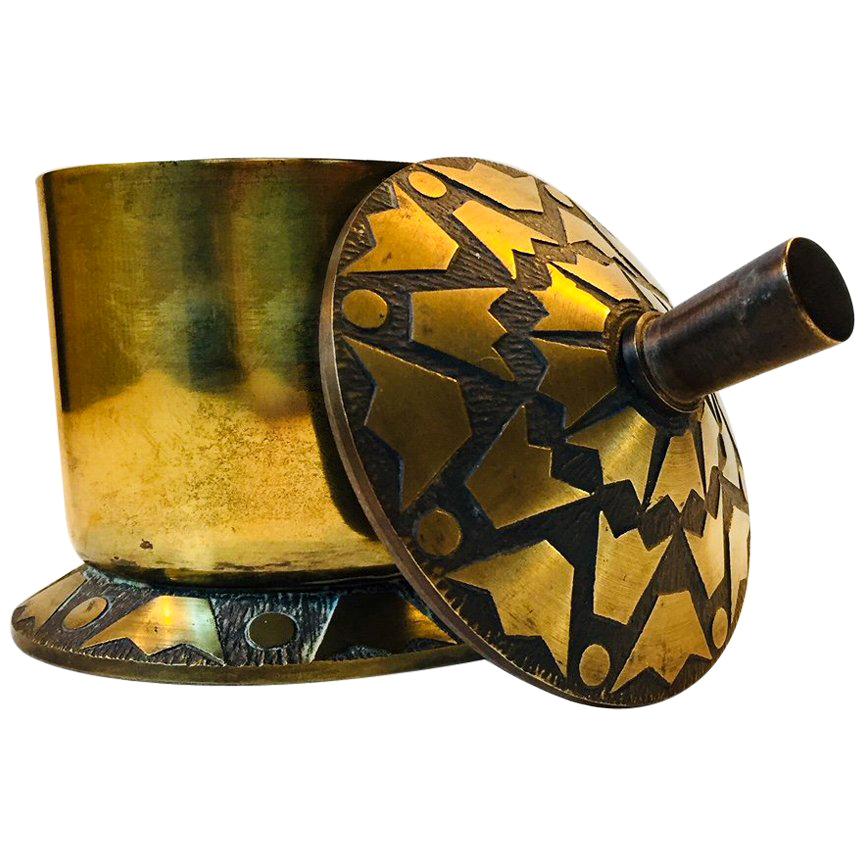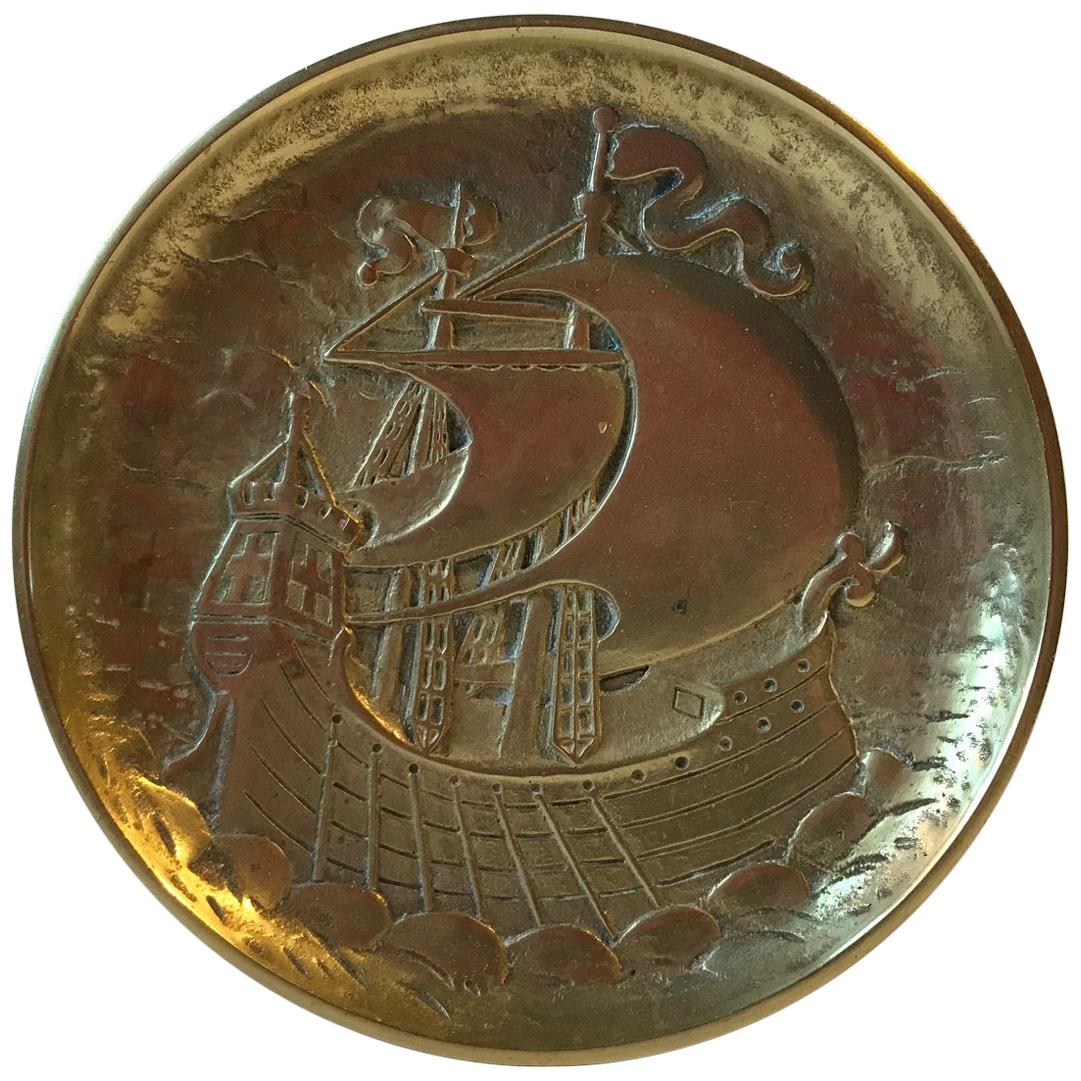Items Similar to Art Deco Bronze Dish by N. Dam Ravn for Nordisk Malm, 1930s
Want more images or videos?
Request additional images or videos from the seller
1 of 7
Art Deco Bronze Dish by N. Dam Ravn for Nordisk Malm, 1930s
About the Item
Art Deco bronze bowl or small charger with relief motif of a female horn blower in the field. It is designed by danish N. Dam Ravn and manufactured by Nordisk Malm in Denmark during the 1930s. The same period Just Andersen took the world by storm with his exquisite bronze pieces. The bowl is signed by the designer just below the woman.
- Creator:N. Dam Ravn (Designer)
- Dimensions:Height: 0.6 in (1.5 cm)Diameter: 6.7 in (17 cm)
- Style:Art Deco (Of the Period)
- Materials and Techniques:
- Place of Origin:
- Period:
- Date of Manufacture:1930s
- Condition:Wear consistent with age and use. Wellkept antique order.
- Seller Location:Esbjerg, DK
- Reference Number:1stDibs: LU1782219830562
About the Seller
4.9
Platinum Seller
These expertly vetted sellers are 1stDibs' most experienced sellers and are rated highest by our customers.
Established in 2010
1stDibs seller since 2016
1,081 sales on 1stDibs
Typical response time: 1 hour
- ShippingRetrieving quote...Ships From: Esbjerg, Denmark
- Return PolicyA return for this item may be initiated within 14 days of delivery.
More From This SellerView All
- Art Deco Bronze Dish with Bow Hunter by N. Dam Ravn, Denmark, 1930sBy N. Dam RavnLocated in Esbjerg, DKArt Deco bronze bowl with centre motif of hunter and deer in relief. It was designed by Danish Sculptor N. Dam Ravn and manufactured by Nordisk Malm in Denmark during the 1930s. The ...Category
Vintage 1930s Danish Art Deco Decorative Bowls
MaterialsBronze
- Art Deco Bronze Cigarette Box with Soldier by N. Dam Ravn, Denmark, 1930sBy N. Dam RavnLocated in Esbjerg, DK- Heavy Art Deco bronze box with soldier on horse in relief. - Art deco interpretation of medieval themes - Clean and strict architectural design despite the Classic motif. - Gold...Category
Vintage 1930s Danish Art Deco Cigar Boxes and Humidors
MaterialsBronze
- Vintage Danish Bronze Zodiac Dish from Nordisk Malm, 1940sLocated in Esbjerg, DKBronze bowl/dish/ashtray with Zodiac motifs, manufactured and designed by Nordisk Malm in Denmark in the late 1940sCategory
Vintage 1940s Danish Art Deco Decorative Dishes and Vide-Poche
MaterialsBronze
- Danish Art Deco Trinket in Bronze by Nordisk Malm, 1930sBy Nordisk MalmLocated in Esbjerg, DKLidded bronze jar, trinket or cigarette container decorated with crown motif's. Manufactured and designed by Nordisk Malm in Denmark during the 19...Category
Vintage 1930s Danish Art Deco Jars
MaterialsBronze
- Art Deco Disko Metal Cigar Box with Motif' by N. Dam Ravn, Denmark, 1930sBy N. Dam RavnLocated in Esbjerg, DKBeautiful Disko metal cigar box with cedar wood interior. It was designed by Danish sculptor N. Dam Ravn in the 1930s. Manufactured by Nordisk Malm. The style and material used is re...Category
Vintage 1930s Danish Art Deco Cigar Boxes and Humidors
- Art Deco Bronze Dish with Frigate, 1930sLocated in Esbjerg, DKA nautical themed heavy bronze dish or ashtray depicting a 17th century Frigate (Fregat) battleship. It was made in Denmark during the 1930s. Distinct Art Deco styling to the slightl...Category
Vintage 1930s Danish Art Deco Decorative Dishes and Vide-Poche
MaterialsBronze
You May Also Like
- Wmf, Germany, Round Art Deco Bronze Dish, 1930s / 40sLocated in Copenhagen, DKWMF, Germany. Round Art Deco bronze dish. 1930s / 40s. Diameter: 33 cm. In excellent condition.Category
Vintage 1930s German Decorative Dishes and Vide-Poche
MaterialsBronze
- Just Andersen Art Deco Light Bronze Dish Denmark 1930sBy Just AndersenLocated in Valby, 84Just Andersen Art Deco dish in beautiful patinaed light bronze made in Denmark in the 1930's. This dish is the perfect piece as a decorative element but can also be used as a fruit or nut bowl or whatever else you could think of. The dish is signed Just Andersen LB 1734. Art Deco, short for the French Arts Décoratifs, and sometimes just called Deco, is a style of visual arts, architecture, and product design, that first appeared in France in the 1910s (just before World War I), and flourished in the United States and Europe during the 1920s and 1930s. Through styling and design of the exterior and interior of anything from large structures to small objects, including how people look (clothing, fashion and jewelry), Art Deco has influenced bridges, buildings (from skyscrapers to cinemas), ships...Category
Vintage 1930s Danish Scandinavian Modern Decorative Dishes and Vide-Poche
MaterialsBronze
- Jean Besnard Art Deco Ceramic Dish, France, 1930sBy Jean BesnardLocated in La Teste De Buch, FRCeramic dish by renowned French potter Jean Besnard. Partially glazed etched decor. Made in France in the 1930s. Marked J Besnard.Category
Vintage 1930s French Art Deco Ceramics
MaterialsCeramic
- Jean Besnard Art Deco Ceramic Dish, France 1930sBy Jean BesnardLocated in La Teste De Buch, FRCeramic dish by renowned French potter Jean Besnard. Partially glazed etched decor. Made in France in the 1930s. Monogrammed JB.Category
Vintage 1930s French Art Deco Ceramics
MaterialsCeramic
- Agentor Art Deco Bronze tray Denmark 1930sLocated in Valby, 84Beautiful patinaed Art Deco Bronze dish by danish manufacture Agentor from the 1930's. The Dish has the motive of a woman running with her hunting dog next to her. This dish is the perfect piece as a decorative element but can also be used as a fruit or nut bowl or whatever else you could think of. The dish is signed Agentor Bronce number 47. Art Deco, short for the French Arts Décoratifs, and sometimes just called Deco, is a style of visual arts, architecture, and product design, that first appeared in France in the 1910s (just before World War I), and flourished in the United States and Europe during the 1920s and 1930s. Through styling and design of the exterior and interior of anything from large structures to small objects, including how people look (clothing, fashion and jewelry), Art Deco has influenced bridges, buildings (from skyscrapers to cinemas), ships, ocean liners, trains, cars, trucks, buses, furniture, and everyday objects like radios and vacuum cleaners. It got its name after the 1925 Exposition internationale des arts décoratifs et industriels modernes (International Exhibition of Modern Decorative and Industrial Arts) held in Paris. Art Deco combined modern styles with fine craftsmanship and rich materials. During its heyday, it represented luxury, glamour, exuberance, and faith in social and technological progress. From its outset, Art Deco was influenced by the bold geometric forms of Cubism and the Vienna Secession; the bright colours of Fauvism and of the Ballets Russes; the updated craftsmanship of the furniture of the eras of Louis XVI and Louis Philippe I; and the exoticized styles of China, Japan, India, Persia, ancient Egypt and Maya art. It featured rare and expensive materials, such as ebony and ivory, and exquisite craftsmanship. The Empire State Building, Chrysler Building, and other skyscrapers of New York City built during the 1920s and 1930s are monuments to the style. In the 1930s, during the Great Depression, Art Deco became more subdued. New materials arrived, including chrome plating, stainless steel and plastic. A sleeker form of the style, called Streamline Moderne, appeared in the 1930s, featuring curving forms and smooth, polished surfaces. Art Deco is one of the first truly international styles, but its dominance ended with the beginning of World War II and the rise of the strictly functional and unadorned styles of modern architecture and the International Style of architecture that followed. This dish are the perfect detail for any interior from the modern Wabi Sabi style...Category
Vintage 1930s Danish Art Deco Decorative Dishes and Vide-Poche
MaterialsBronze
- Evan Jensen Bronze Dish, Denmark, 1930sBy Evan JensenLocated in Valby, 84Bronze Art deco dish/charger by Danish artist Evan Jensen from the 1930's in a beautiful original condition, the dish is signed Evan Jensen Copenhagen Bronze and has model number 320. The dish has a very decorative image of a deer on the front. The dish is the perfect dish to have standing as a piece of art but can also be used as a bowl to store stuff like fruit or nuts or whatever else you could think of. Art Deco, short for the French Arts Décoratifs, and sometimes just called Deco, is a style of visual arts, architecture, and product design, that first appeared in France in the 1910s (just before World War I), and flourished in the United States and Europe during the 1920s and 1930s. Through styling and design of the exterior and interior of anything from large structures to small objects, including how people look (clothing, fashion and jewelry), Art Deco has influenced bridges, buildings (from skyscrapers to cinemas), ships, ocean liners, trains, cars, trucks, buses, furniture, and everyday objects like radios and vacuum cleaners. It got its name after the 1925 Exposition internationale des arts décoratifs et industriels modernes (International Exhibition of Modern Decorative and Industrial Arts) held in Paris. Art Deco combined modern styles with fine craftsmanship and rich materials. During its heyday, it represented luxury, glamour, exuberance, and faith in social and technological progress. From its outset, Art Deco was influenced by the bold geometric forms of Cubism and the Vienna Secession; the bright colours of Fauvism and of the Ballets Russes; the updated craftsmanship of the furniture of the eras of Louis XVI and Louis Philippe I; and the exoticized styles of China, Japan, India, Persia, ancient Egypt and Maya art. It featured rare and expensive materials, such as ebony and ivory, and exquisite craftsmanship. The Empire State Building, Chrysler Building, and other skyscrapers of New York City built during the 1920s and 1930s are monuments to the style. In the 1930s, during the Great Depression, Art Deco became more subdued. New materials arrived, including chrome plating, stainless steel and plastic. A sleeker form of the style, called Streamline Moderne, appeared in the 1930s, featuring curving forms and smooth, polished surfaces. Art Deco is one of the first truly international styles, but its dominance ended with the beginning of World War II and the rise of the strictly functional and unadorned styles of modern architecture and the International Style of architecture that followed. This dish is the perfect detail for any interior from the modern Wabi Sabi style...Category
Vintage 1930s Danish Scandinavian Modern Decorative Dishes and Vide-Poche
MaterialsBronze
Recently Viewed
View AllMore Ways To Browse
Vintage Art Deco Bronze
Vintage Kitchens Of The 1930s
Art Deco Dish
A Dammer
Bronze Deco Woman
Art Deco Bronze Woman
Art Deco Horn
Woman With Basket
Dishes Denmark
Art Deco Bronze Bowl
Nordisk Vintage
Bronze Reliefs Art Deco
Vintage Blower
Just Andersen Bronze
Small Bronze Bowls
Female Bowl
Storm Bronze
Art Deco Charger





